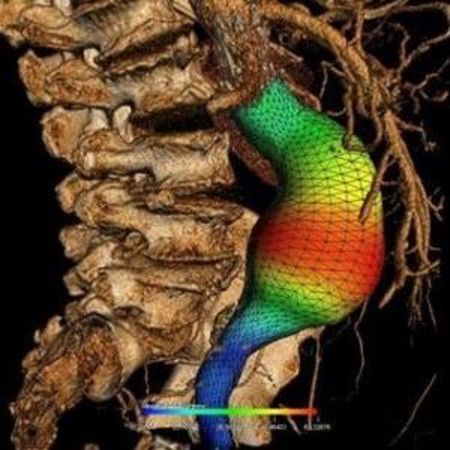Researchers have developed a new technique for creating virtual models in the angiography room, which can make treatment of abdominal aortic aneurysms safer. The technique is the result of collaboration between the University of Montreal Hospital Research Centre (CRCHUM) and the university's departments of radiology, radiation oncology, and nuclear medicine. The findings were presented by Dr. Gilles Soulez at the Cardiovascular and Interventional Radiological Society of Europe (CIRSE) Congress 2015.
For 25 years, Dr. Soulez has been involved in developing medical imaging technologies to prevent complication for, operate on, and monitor patients with abdominal aortic aneurysms. The main problem has been the ability to properly visualise the area to be treated. "We want to develop new software to maximise the use of images generated with current ultrasound, scanning, and magnetic resonance imaging (MRI) technologies to ultimately provide more personalised treatments," he said.
Currently, a simple abdominal ultrasound or measurement of the aorta with a scanner can detect patients at risk of aneurysm rupture. Beyond 5 cm for women and 5.5 cm for men, surgery is usually recommended. However, operations have their own risks, so researchers want to refine screening to provide the most appropriate treatments for patients who really need surgery.
To avoid rupturing the small balloon (pictured) formed by the abdominal aortic aneurysm, two treatment options exist: open surgery to replace the diseased section or endovascular grafting, in which a catheter is inserted in the groin to deliver a stent-graft through the blood vessels to the aneurysm. This option is less invasive, but in some patients, the morphology of the aneurysm is not suited to this kind of treatment. Using scanner images, Dr. Soulez's research provides three-dimensional images of all components of the aneurysm — ie, the light, the thrombus or clot, the wall, and the calcification.
"The grid is used to establish growth profiles of the aneurysm. We are now working to create simulations to better predict the risk of rupture, adding biomechanical properties such as tissue elasticity and connectivity at each pixel of the grid," the radiologist explained. "We hope this simulation-operation model will improve the accuracy of the procedure."
Currently, the operation is performed using static images taken by a scanner before the procedure. The procedure itself is done under fluoroscopy by injecting dye into the vessels to be treated. "The image produced by x-ray shows the dye in the vessels and the stent being inserted, but not the wall. This approach requires a lot of dye, which can be toxic for the patient if used in excessive amounts," Dr. Soulez said.
Following the stent-graft operation, patients have an annual scan. A new ultrasound technology called elastography that was developed in collaboration with Guy Cloutier, also of CRCHUM, holds the promise of not only effectively identifying leaks, but also evaluating how the aneurysm is healing.
Source: University of Montreal
Image credit: Claude Kauffmann, CRCHUM
For 25 years, Dr. Soulez has been involved in developing medical imaging technologies to prevent complication for, operate on, and monitor patients with abdominal aortic aneurysms. The main problem has been the ability to properly visualise the area to be treated. "We want to develop new software to maximise the use of images generated with current ultrasound, scanning, and magnetic resonance imaging (MRI) technologies to ultimately provide more personalised treatments," he said.
Currently, a simple abdominal ultrasound or measurement of the aorta with a scanner can detect patients at risk of aneurysm rupture. Beyond 5 cm for women and 5.5 cm for men, surgery is usually recommended. However, operations have their own risks, so researchers want to refine screening to provide the most appropriate treatments for patients who really need surgery.
To avoid rupturing the small balloon (pictured) formed by the abdominal aortic aneurysm, two treatment options exist: open surgery to replace the diseased section or endovascular grafting, in which a catheter is inserted in the groin to deliver a stent-graft through the blood vessels to the aneurysm. This option is less invasive, but in some patients, the morphology of the aneurysm is not suited to this kind of treatment. Using scanner images, Dr. Soulez's research provides three-dimensional images of all components of the aneurysm — ie, the light, the thrombus or clot, the wall, and the calcification.
"The grid is used to establish growth profiles of the aneurysm. We are now working to create simulations to better predict the risk of rupture, adding biomechanical properties such as tissue elasticity and connectivity at each pixel of the grid," the radiologist explained. "We hope this simulation-operation model will improve the accuracy of the procedure."
Currently, the operation is performed using static images taken by a scanner before the procedure. The procedure itself is done under fluoroscopy by injecting dye into the vessels to be treated. "The image produced by x-ray shows the dye in the vessels and the stent being inserted, but not the wall. This approach requires a lot of dye, which can be toxic for the patient if used in excessive amounts," Dr. Soulez said.
Following the stent-graft operation, patients have an annual scan. A new ultrasound technology called elastography that was developed in collaboration with Guy Cloutier, also of CRCHUM, holds the promise of not only effectively identifying leaks, but also evaluating how the aneurysm is healing.
Source: University of Montreal
Image credit: Claude Kauffmann, CRCHUM
Latest Articles
healthmanagement, angiography, ultrasound, abdominal aortic aneurysm, x-rays, 3D, blood vessels
Researchers have developed a new technique for creating virtual models in the angiography room, which can make treatment of abdominal aortic aneurysms safer. The technique is the result of collaboration between the University of Montreal Hospital Research



























